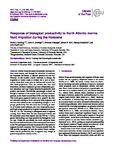Response of biological productivity to North Atlantic marine front migration during the Holocene
| dc.contributor.author | Harning, DJ | |
| dc.contributor.author | Jennings, AE | |
| dc.contributor.author | Köseoğlu, D | |
| dc.contributor.author | Belt, Simon | |
| dc.contributor.author | Geirsdóttir, Á | |
| dc.contributor.author | Sepúlveda, J | |
| dc.date.accessioned | 2021-02-09T09:41:31Z | |
| dc.date.issued | 2021-02-08 | |
| dc.identifier.issn | 1814-9324 | |
| dc.identifier.issn | 1814-9332 | |
| dc.identifier.uri | http://hdl.handle.net/10026.1/16866 | |
| dc.description.abstract |
<jats:p>Abstract. Marine fronts delineate the boundary between distinct water masses and, through the advection of nutrients, are important facilitators of regional productivity and biodiversity. As the modern climate continues to change, the migration of frontal zones is evident, but a lack of information about their status prior to instrumental records hinders future projections. Here, we combine data from lipid biomarkers (archaeal isoprenoid glycerol dibiphytanyl glycerol tetraethers and algal highly branched isoprenoids) with planktic and benthic foraminifera assemblages to detail the biological response of the marine Arctic and polar front migrations on the North Iceland Shelf (NIS) over the last 8 kyr. This multi-proxy approach enables us to quantify the thermal structure relating to Arctic and polar front migration and test how this influences the corresponding changes in local pelagic productivity. Our data show that following an interval of Atlantic water influence, the Arctic front and its associated high pelagic productivity migrated southeastward to the NIS by ∼6.1 ka. Following a subsequent trend in regional cooling, Polar Water from the East Greenland Current and the associated polar front spread onto the NIS by ∼3.8 ka, greatly diminishing local algal productivity through the Little Ice Age. Within the last century, the Arctic and polar fronts have moved northward back to their current positions relative to the NIS and helped stimulate the productivity that partially supports Iceland's economy. Our Holocene records from the NIS provide analogues for how the current frontal configuration and the productivity that it supports may change as global temperatures continue to rise. </jats:p> | |
| dc.format.extent | 379-396 | |
| dc.language | en | |
| dc.language.iso | en | |
| dc.publisher | Copernicus GmbH | |
| dc.title | Response of biological productivity to North Atlantic marine front migration during the Holocene | |
| dc.type | journal-article | |
| dc.type | Journal Article | |
| plymouth.author-url | https://www.webofscience.com/api/gateway?GWVersion=2&SrcApp=PARTNER_APP&SrcAuth=LinksAMR&KeyUT=WOS:000618623200001&DestLinkType=FullRecord&DestApp=ALL_WOS&UsrCustomerID=11bb513d99f797142bcfeffcc58ea008 | |
| plymouth.issue | 1 | |
| plymouth.volume | 17 | |
| plymouth.publisher-url | https://cp.copernicus.org/articles/17/379/2021/ | |
| plymouth.publication-status | Published online | |
| plymouth.journal | Climate of the Past | |
| dc.identifier.doi | 10.5194/cp-17-379-2021 | |
| plymouth.organisational-group | /Plymouth | |
| plymouth.organisational-group | /Plymouth/Faculty of Science and Engineering | |
| plymouth.organisational-group | /Plymouth/Faculty of Science and Engineering/School of Geography, Earth and Environmental Sciences | |
| plymouth.organisational-group | /Plymouth/REF 2021 Researchers by UoA | |
| plymouth.organisational-group | /Plymouth/REF 2021 Researchers by UoA/UoA07 Earth Systems and Environmental Sciences | |
| plymouth.organisational-group | /Plymouth/Research Groups | |
| plymouth.organisational-group | /Plymouth/Research Groups/Marine Institute | |
| plymouth.organisational-group | /Plymouth/Users by role | |
| plymouth.organisational-group | /Plymouth/Users by role/Academics | |
| plymouth.organisational-group | /Plymouth/Users by role/Researchers in ResearchFish submission | |
| dcterms.dateAccepted | 2021-01-04 | |
| dc.rights.embargodate | 2021-2-10 | |
| dc.identifier.eissn | 1814-9332 | |
| dc.rights.embargoperiod | Not known | |
| rioxxterms.versionofrecord | 10.5194/cp-17-379-2021 | |
| rioxxterms.licenseref.uri | http://www.rioxx.net/licenses/all-rights-reserved | |
| rioxxterms.licenseref.startdate | 2021-02-08 | |
| rioxxterms.type | Journal Article/Review |


